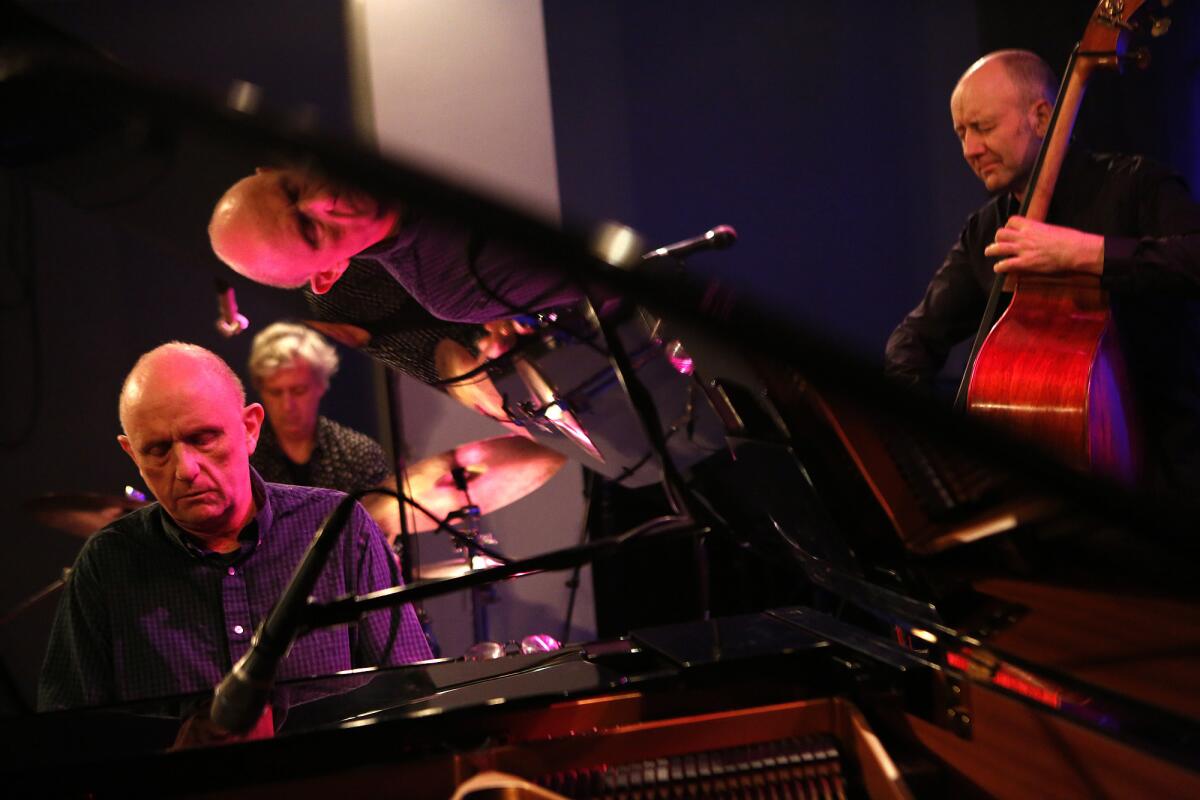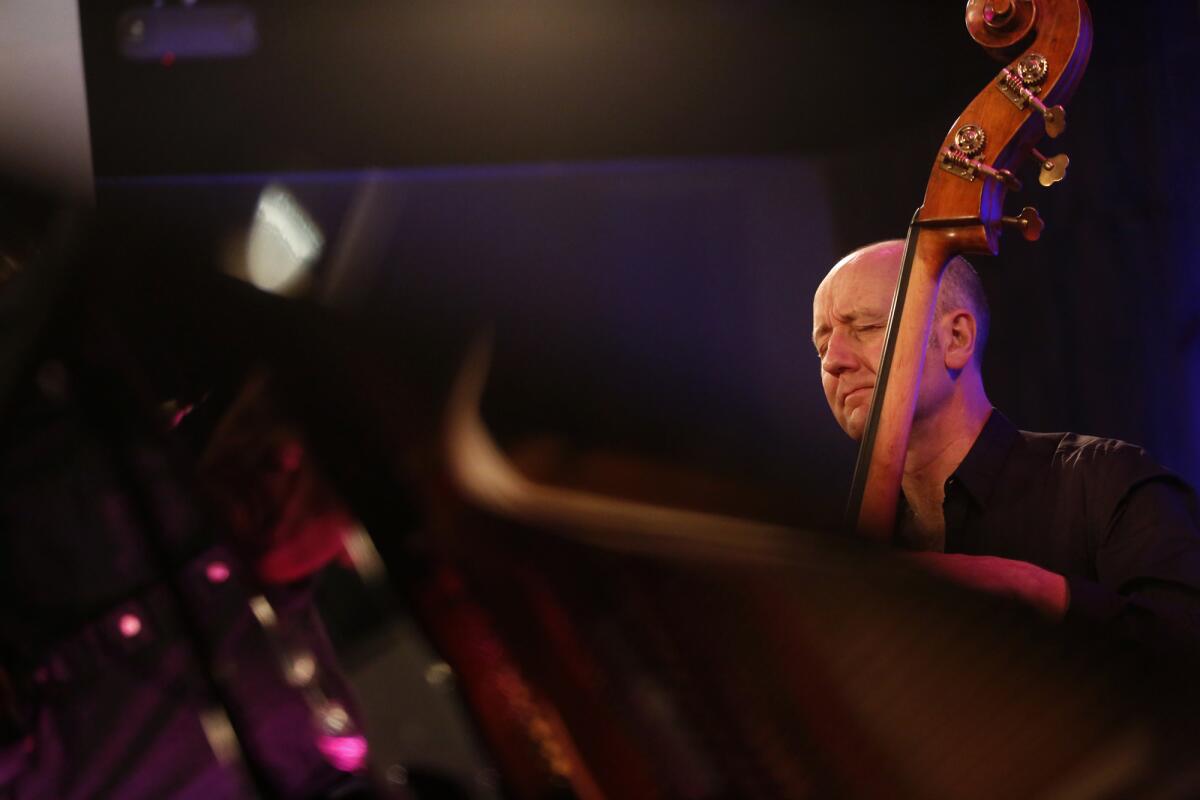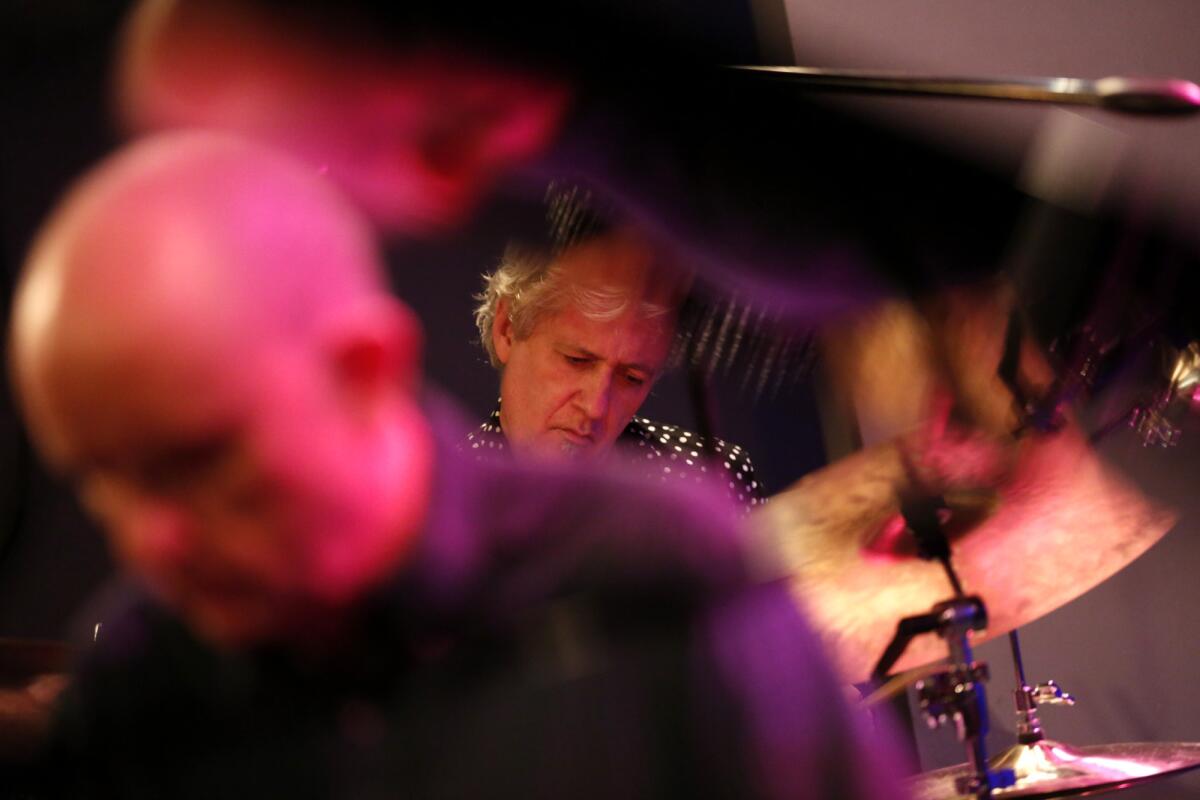The Necks and vortex of sound that makes the jazz trio among the world’s greatest forces in music

The Necks, featuring Chris Abrahams, from left, on piano, Tony Buck on drums and Lloyd Swanton, on bass, at The Blue Whale in downtown Los Angeles.
- Share via
The Necks have made few mistakes in the last 30 years. In fact, there may have been only one, and it was the Australian trio’s first decision: not to play in front of a live audience.
In the early ‘80s, bassist Lloyd Swanton, pianist Chris Abrahams and drummer Tony Buck were all living in Sydney. After playing in various jazz ensembles, they joined forces.
“In 1986, we got together and talked about this concept of having a band,” Swanton told me. “As I recall it, the main idea was to be in the moment, where the final result didn’t matter. Part of that was to perform only in private.”
This changed when they were coaxed into performing at Sydney University, where they had been rehearsing, sometimes several times a week.
“We didn’t want an audience because we just didn’t want any outside pressure on this process that we were developing,” Swanton said. “But we decided it was worth trying it out in front of an audience and it was a big success. That’s where it all began.”
Since then, they’ve slowly built a reputation that might merit them some kind of horrible name like “most famous unknown band in the world.” Their two sets a couple of weeks ago in Los Angeles at the Blue Whale would easily be in my top three albums of the year — if they’d been properly recorded.
There are no written motifs or arrangements before the band starts to play. Pieces last an hour, almost without fail. Remarkably, this length is internalized, as is much Necks magic: there are no watches or time-keeping devices on stage or in the studio. Necks music is not harmed by being called “repetitive” or “simple” or “hypnotic.” Most tracks begin with a band member setting up a certain pattern, which the others respond to.

The Necks, featuring Lloyd Swanton, on bass, at The Blue Whale in Los Angeles.
What happens after that is hard to pin down, much like one of those maddening visual puzzles in which everything is the same except for one bit. The three play together but without any traditional jazz background/foreground division. If Abrahams is hammering away and making a blizzard of related thirds, Swanton may be bowing his bass in a key that relates to what Abrahams is doing but isn’t necessarily in the same key or tempo.
Buck’s role as drummer is rarely, if ever, to grab onto Swanton’s bass line and drive the music forward. The dialectic engine of the Necks is three musicians completely lost in their own world, falling off the edge and somehow cuing one another.
And that is the fun for a Necks watcher. When do they make their decisions? How do they know when they’re going to change? The rules for studio albums and live shows are related but quite distinct.
On their latest studio album, “Vertigo” (Northern Spy), there are clouds of droning and feedback, Hammond organ, synth swoops and all sorts of auxiliary sounds they don’t allow themselves live. The studio albums pick up where the live shows end — the band, without any discussion, simply starts to play.
For the albums, they allow themselves to listen back to what they’ve done, embellish certain bits and edit things. In the case of “Vertigo,” this led to one of their most striated, least-repetitive albums, as close to their beloved ‘70s-era Miles Davis as they’ve ever come. Minutes 20 to 30 are close indeed to a variation on “In a Silent Way,” featuring long stretches of Abrahams’ electric piano, unaccompanied, followed by a treated version of that piano working in dialogue with Buck manipulating what might be a bag full of Lego blocks.
Live, things tend to charge forward because that’s the linear nature of time. Their first set at Blue Whale was a pale blue thing, a clutch of moiré dappling between Abrahams rattling some patterns that would not have been out of place on a Reich record and Swanton reacting by setting up motifs that outlined specific ways of hearing that theme. Buck acted more like a curtain, shaping what was going on stage left, coloring in the bits the other two had missed. (Against tradition, once again, Abrahams performed on the piano with his back to Swanton, who was center stage, and Buck, stage right, facing Abrahams’ back. In this way, the massive harp of the piano body was not between them, bringing Abrahams physically closer to his band mates.)

Chris Abrahams, left, on piano, and Tony Buck on drums.
The second set was one of the most remarkable things I’ve seen. Much of the credit goes to Buck, who began the piece with various knockers and bits of wood, plus a child’s toy that presents a small drumhead on a stick attached to two swinging balls that strike the drum, or whatever else is nearby. His particularly generative and sneaky gambit was to take a long and pointed drumstick, push it against the head of the kick drum closest to his foot, and run his fingers along the wood. This produced a long, low bass tone. Close your eyes and you’d swear Swanton was playing something. Close your eyes at a Necks show and you’d swear any number of things are happening physically, because of what you think you are hearing.
What happened next falls into that dodgy category of “you had to be there.” I can describe it this way: the whole thing built into a roiling, psychedelic vortex that descended slightly and stopped. What else happened is purely speculative.
The trio have talked extensively in interviews about mind-reading and all the communication they do without talking, and this performance made me think there’s a moment in a Necks show much like a poker game. One of the musicians does something, and only the other two can hear it — what poker players call “the tell.” There are no abrupt shifts in Necks pieces; everything ramps up and down at a deliciously low incline. But something rings out and gives another player an idea of how to introduce the next, and possibly final, idea.
I can’t overstress how important and rich this band’s work is. If I told you to buy everything they’ve ever done, I would not feel a moment’s remorse. The band recommends “Drive By” (2003) and “Chemist” (2006) for starters; I am partial to the aptly named “Silverwater” (2009), which I swear uses more audio to entrance the listener. I am also fond of the recent “Open” (2013), perhaps their gentlest and slowest work.
Certainly, there are other important instrumental bands in the world (sort of), but nobody else does so much with so little. Sadly, the cost of American visas makes their trips to the States rare. But if they appear within a plane flight of you, don’t hesitate: carpe diem. If they’ve ever played a bad show, there is no record of it.
Twitter: @sfj
More to Read
The biggest entertainment stories
Get our big stories about Hollywood, film, television, music, arts, culture and more right in your inbox as soon as they publish.
You may occasionally receive promotional content from the Los Angeles Times.










